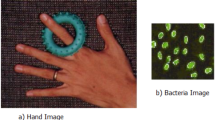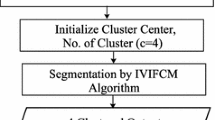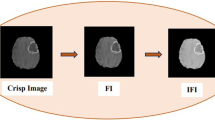Abstract
In various medical imaging studies, the segmentation of the medical image is a crucial step. Due to the inherent behavior of the images, the computerized tomography (CT) scan/magnetic resonance imaging (MRI) images are not clear. As the medical images are captured using electronic devices, these images are ambiguous and unclear. This ambiguity in the images is due to factors related to noise and the environment while capturing images. A fuzzy set is a valuable method to deal with data uncertainty. In this paper, a novel clustering approach based upon a fuzzy concept is proposed, which enhances the vague MRI/CT scan image before segmentation. Initially, the image noise is minimized by processing eight immediate neighborhood pixels around each pixel in an image. After noise processing, upper and lower membership levels of the image are computed. Hamacher T-conorm is used as an aggregation operator to construct a new membership function using upper and lower membership levels. The enhanced image, created using the new membership function, is then segmented using Gaussian kernel-based fuzzy c means clustering. The experiment is performed on MRI/CT scan brain tumor images. Real data experiments demonstrate that the proposed algorithm has better performance when compared with existing methods both quantitatively and qualitatively. It is observed that even in the presence of noise, the proposed method exhibits better efficiency.









Similar content being viewed by others
Explore related subjects
Discover the latest articles, news and stories from top researchers in related subjects.References
Abualigah L (2020a) Group search optimizer: a nature-inspired meta-heuristic optimization algorithm with its results, variants, and applications. Neural Comput Appl:1–24
Abualigah L (2020b) Multi-verse optimizer algorithm: a comprehensive survey of its results, variants, and applications. Neural Comput Appl:1–21
Abualigah L, Diabat A (2020a) A comprehensive survey of the grasshopper optimization algorithm: results, variants, and applications. Neural Comput Appl:1–24
Abualigah L, Diabat A (2020b) A novel hybrid antlion optimization algorithm for multi-objective task scheduling problems in cloud computing environments. Cluster Comput:1–19
Abualigah LM, Khader AT (2017) Unsupervised text feature selection technique based on hybrid particle swarm optimization algorithm with genetic operators for the text clustering. J Supercomput 73(11):4773–4795
Abualigah LM, Khader AT, Hanandeh ES, Gandomi AH (2017) A novel hybridization strategy for krill herd algorithm applied to clustering techniques. Appl Soft Comput 60:423–435
Abualigah LM, Khader AT, Hanandeh ES (2018a) A combination of objective functions and hybrid krill herd algorithm for text document clustering analysis. Eng Appl Artif Intell 73:111–125
Abualigah LM, Khader AT, Hanandeh ES (2018b) Hybrid clustering analysis using improved krill herd algorithm. Appl Intell 48(11):4047–4071
Abualigah LM, Khader AT, Hanandeh ES (2018c) A new feature selection method to improve the document clustering using particle swarm optimization algorithm. J Comput Sci 25:456–466
Abualigah LMQ (2019) Feature selection and enhanced krill herd algorithm for text document clustering. Springer, Berlin
Abualigah LMQ, Hanandeh ES (2015) Applying genetic algorithms to information retrieval using vector space model. Int J Comput Sci Eng Appl 5(1):19
Atanassov KT (1999) Intuitionistic fuzzy sets. In: Intuitionistic fuzzy sets. Springer, pp 1–137
Bezdek JC (1981) Objective function clustering. In: Pattern recognition with fuzzy objective function algorithms. Springer, pp 43–93
Chaira T (2011) A novel intuitionistic fuzzy C means clustering algorithm and its application to medical images. Appl Soft Comput 11(2):1711–1717
Chaira T (2013) Contrast enhancement of medical images using type II fuzzy set. In: 2013 national conference on communications (NCC). IEEE, pp 1–5
Chaira T (2014) An improved medical image enhancement scheme using type II fuzzy set. Appl Soft Comput 25:293–308
Chaira T (2019) Fuzzy set and its extension. Wiley Online Library, Hoboken
Chintalapudi KK, Kam M (1998) A noise-resistant fuzzy C means algorithm for clustering. In: 1998 IEEE international conference on fuzzy systems proceedings. IEEE World Congress on Computational Intelligence (Cat. No. 98CH36228), vol 2. IEEE, pp 1458–1463
Dombi J (1982) A general class of fuzzy operators, the demorgan class of fuzzy operators and fuzziness measures induced by fuzzy operators. Fuzzy Sets Syst 8(2):149–163
Ensafi P, Tizhoosh HR (2005) Type-2 fuzzy image enhancement. In: International conference image analysis and recognition. Springer, pp 159–166
Kaur P (2016) Improved version of kernelized fuzzy C means using credibility. Int J Comput Sci Netw 5(1):50–54
Kaur P, Lamba I, Gosain A (2011a) Kernelized type-2 fuzzy C-means clustering algorithm in segmentation of noisy medical images. In: 2011 IEEE recent advances in intelligent computational systems. IEEE, pp 493–498
Kaur P, Lamba I, Gosain A (2011b) A robust method for image segmentation of noisy digital images. In: 2011 IEEE international conference on fuzzy systems (FUZZ-IEEE 2011). IEEE, pp 1656–1663
Kaur P, Soni A, Gosain A, India II (2012) Novel intuitionistic fuzzy C-means clustering for linearly and nonlinearly separable data. WSEAS Trans Comput 11(3):65–76
Kaur P, Soni A, Gosain A (2013a) Image segmentation of noisy digital images using extended fuzzy C-means clustering algorithm. Int J Comput Appl Technol 47(2–3):198–205
Kaur P, Soni A, Gosain A (2013b) Robust kernelized approach to clustering by incorporating new distance measure. Eng Appl Artif Intell 26(2):833–847
Masulli F, Schenone A (1999) A fuzzy clustering based segmentation system as support to diagnosis in medical imaging. Artif Intell Med 16(2):129–147
Matlab V (2018) 9.4.0.813654 (r2018a). The MathWorks Inc., Natick, MA
Mendel JM (2007) Type-2 fuzzy sets and systems: an overview. IEEE Comput Intell Mag 2(1):20–29
Mendel JM, John RB (2002) Type-2 fuzzy sets made simple. IEEE Trans Fuzzy Syst 10(2):117–127
Rhee FCH, Hwang C (2001) A type-2 fuzzy c-means clustering algorithm. In: Proceedings joint 9th IFSA world congress and 20th NAFIPS international conference (Cat. No. 01TH8569), vol 4. IEEE, pp 1926–1929
Tsai DM, Lin CC (2011) Fuzzy c-means based clustering for linearly and nonlinearly separable data. Pattern Recogn 44(8):1750–1760
Weber S (1983) A general concept of fuzzy connectives, negations and implications based on t-norms and t-conorms. Fuzzy Sets Syst 11(1–3):115–134
Yager RR, RR Y (1980) On a general class of fuzzy connectives
Zadeh LA (1965) Fuzzy sets. Inf Control 8(3):338–353
Zhang DQ, Chen SC (2003) Clustering incomplete data using kernel-based fuzzy C-means algorithm. Neural Process Lett 18(3):155–162
Zhang DQ, Chen SC (2004) A novel kernelized fuzzy C-means algorithm with application in medical image segmentation. Artif Intell Med 32(1):37–50
Author information
Authors and Affiliations
Corresponding author
Ethics declarations
Conflict of interest
All the authors declare that there is no conflict of interest in publishing this paper.
Ethical approval
This article does not contain any studies with human participants or animals performed by any of the authors.
Additional information
Communicated by V. Loia.
Publisher's Note
Springer Nature remains neutral with regard to jurisdictional claims in published maps and institutional affiliations.
Rights and permissions
About this article
Cite this article
Kaur, P., Chaira, T. A novel fuzzy approach for segmenting medical images. Soft Comput 25, 3565–3575 (2021). https://doi.org/10.1007/s00500-020-05386-6
Published:
Issue Date:
DOI: https://doi.org/10.1007/s00500-020-05386-6




